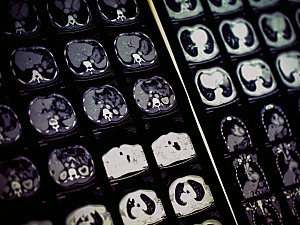In 2020, Brigham and Women’s Hospital researchers reported that first-degree relatives of patients with pulmonary fibrosis have high rates of interstitial lung abnormalities (ILA), even if the relative’s pulmonary fibrosis is sporadic rather than familial.
Now, Jonathan A. Rose, MD, MS, a fellow in the Division of Pulmonary and Critical Care Medicine at the Brigham, Gary M. Hunninghake, MD, MPH, director of the Interstitial Lung Disease Program, and colleagues have published two-year follow-up of the Clinical Genetics and Screening for Pulmonary Fibrosis (CGS-PF) registry study. They report in the American Journal of Respiratory and Critical Care Medicine that radiologic progression of ILA was common in the relatives and may be associated with accelerated loss of lung function.
Methods
The researchers studied 73 first-degree relatives of patients with pulmonary fibrosis in the CGS-PF study who had both baseline and two-year follow-up CT scans available. Relatives also underwent lung function testing at baseline and follow-up.
Twenty relatives had ILA at baseline, and 53 did not.
Prevalence of ILA
Two-year follow-up CT showed:
- 21 relatives had ILA: 19 who had ILA at baseline and two who developed incident ILA
- 51 relatives were without ILA at both baseline and follow-up
- One relative had ILA at baseline who did not appear to have ILA at follow-up
Radiologic Progression
At two-year follow-up:
- Radiologic progression was noted in 13 of 20 relatives who had ILA at baseline (65%)
- The two relatives who developed incident ILA represented 4% of 53 relatives who did not have ILA at baseline
Of those 15 relatives who had radiologic progression, four were from families with familial pulmonary fibrosis. The others had a single first-degree relative with idiopathic pulmonary fibrosis.
Among the 20 relatives who had baseline ILA:
- Six had definite fibrosis at baseline, and five of them (83%) exhibited radiologic progression on follow-up
- 14 did not have fibrosis at baseline; eight of them (57%) showed progression
Pulmonary Function
At two-year follow-up:
- FEV1, FVC, and DLCO remained reduced in relatives with ILA compared to those without ILA
- Relatives with ILA had significantly greater loss of FEV1 from baseline to follow-up, compared to those without ILA, even after adjustment for covariates (145 mL; P=0.007)
Disease Progression
Of the 20 relatives with ILA at baseline, 9 (45%) had either a relative loss of FVC of >10% or FVC loss of 5%–10% plus imaging progression, which would qualify as disease progression, using criteria modified from the INBUILD trial of progressive pulmonary fibrosis.
Next Steps
These results provide more evidence that relatives of patients with pulmonary fibrosis should be screened for ILA. The researchers are now recruiting additional relatives to increase the power of the study to detect differences between those with and without ILA.
Further longitudinal follow-up will determine whether the rate of lung function loss in relatives is more significant than that in other groups, whether the rate of decline accelerates over time, and whether loss of lung function correlates with other adverse outcomes.
